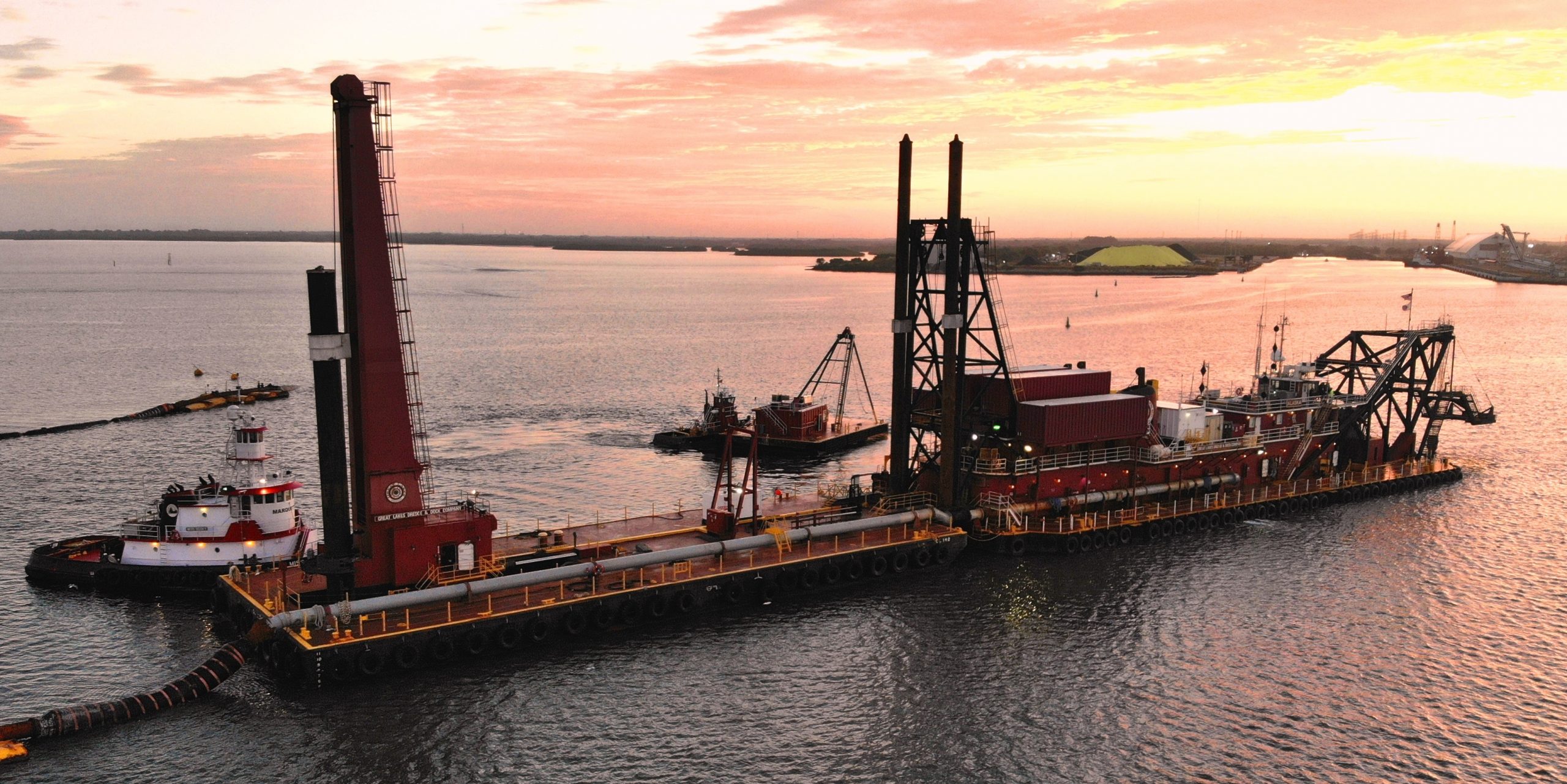Great Lakes Dredge & Dock Company (GLDD) completed the $63 million deepening and widening of Big Bend Channel in April, more than a year ahead of schedule. Work started in October and was scheduled to take 18 months. The U.S. Corps of Engineers Jacksonville District awarded the contract in September 2018.
The Big Bend Channel deepening is part of the overall Tampa Harbor project that encompasses approximately 64 miles of waterways. Big Bend is located in the upper east portion of Tampa Bay and feeds into the terminals of Port Redwing (part of Port Tampa Bay), Mosaic and Tampa Electric Company.
According to Liz Fiocchi, Jacksonville District navigation program manager and Port of Tampa project manager, the Big Bend contract was originally split into four areas: the main access channel that runs east to west, the turning basin at the end of the channel, private berthing areas, and the north to south channel that feeds the Tampa Port Authority. The fourth item, however, was removed from the scope of this project but could be completed at a later date.
“Big Bend Channel is the first new federal channel that the Jacksonville District has built in over 30 years. While there was a channel there, it was much smaller and not federally maintained,” Fiocchi said.
The dredging removed approximately 3.5 million cubic yards of material with the majority of the dredged material coming from the main access channel, and the second largest amount from the turning basin.
The dredging widened the channel by 50 feet and deepened it so it could accommodate larger class vessels. The entrance channel, east/west channel, inner channel, turning basin and private berthing areas off Big Bend were deepened from 34 to 43 feet. The entrance channel was widened from 200 to 250 feet for a length of 1.9 miles.
The project was completed early due to a combination of equipment, manpower and weather.
According to Bill Hanson, vice president of government relations for GLDD, the company got an early start. “We were actually mobilizing in anticipation of the project award, so were able to get started in a matter of days. Although Hurricane Michael did set us back for a bit since many of the FDEP (Florida Department of Environmental Protection) folks based in Tallahassee who needed to approve some of our operational plans were away from their homes. We thank them for working above and beyond the call when they were taking care of their families as well,” Hanson said.
Along with setting pipeline and bringing in tugs, barges and derricks, GLDD deployed two of its most powerful dredges, and two of the largest cutter suction dredges in the U.S., the Alaska and the Carolina, to get the work done quickly and efficiently.

The cutter suction dredge Carolina is the third-largest vessel in the Great Lakes fleet of ten hydraulic dredges. It is 263 feet with a dig depth range of 14 to 84 feet, suction diameter of 34 inches and discharge diameter of 30 inches. Its cutter power is 3,000 hp. The Alaska is 220 feet in length, has a dig depth range of 11 to 87 feet, suction diameter of 34 inches and discharge diameter of 30 inches. The Alaska’s cutter power is 1,500 hp.
While the original contract anticipated blasting would be needed to get through clay, rock and seabed materials in the East Channel and berthing areas, the power of the cutterheads on the dredges made blasting unnecessary and further quickened the completion.
Material dredged from the Big Bend Channel project was deposited at the port-owned 500-acre spoil island in Hillsborough Bay known as Dredge Material Disposal Area 3-D.
GLDD placed pipe under the channel and on top of the disposal site for close to a 1.5-mile pump distance. The placed material created 100 acres of bird nesting and roosting area.
“The intent was that the 14 million cubic yard capacity island would need to be improved and raised in order to accept the 3.5 million cubic yards from this project. While we knew the area would create habitat, we never expected the sheer number of birds. That was a nice unexpected benefit,” Fiocchi said.
Dredging was completed on April 1.
“Great Lakes dug so well, dredging to the required depth plus some level of advanced maintenance, plus allowable overdepth, that in some areas the channel was at 48 feet. Engineers estimated that full maintenance dredging won’t be needed for ten years,” Fiocchi said.
Outside of how quickly the work progressed, Hanson said the project was unique in other ways.
“This project was unique in a lot of ways in that the state and port picked up 90 percent of the costs. It took a lot of hard work by state folks and by Port Tampa leadership under Port Director Paul Anderson. Interestingly as well is that the port and Corps took part in our safety leadership team meetings to make sure we focused on getting everyone home safe at night,” Hanson said.
A group of partners paid for the project. The Corps portion was $47 million, while the Port Tampa Bay, Florida Department of Transportation and two of the largest users of the channel, Tampa Electric Company and Mosaic, a global fertilizer company, contributed the remaining.




